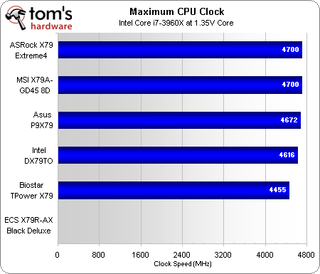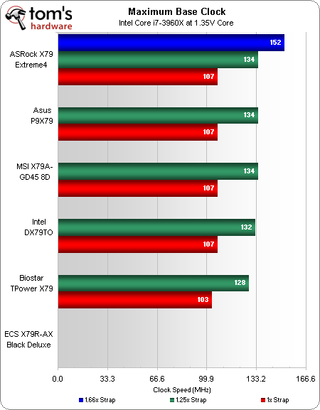Six $200-$260 LGA 2011 Motherboards, Reviewed
We know that Intel's X79 Express platform hosts the fastest desktop processors in the company's portfolio. But can it be made more affordable? We round up the least-expensive $200-$260 motherboards to determine how much you have to give up for cheap X79.
Overclocking
| BIOS Frequency and Voltage settings (for overclocking) | |||
|---|---|---|---|
| Row 0 - Cell 0 | ASRock X79 Extreme4 | Asus P9X79 | Biostar TPower X79 |
| Base Clock | 90-300 MHz (1 MHz) | 80-300 MHz (0.1 MHz) | 80-300 MHz (0.1 MHz) |
| CPU Multiplier | 12x to 60x (1x) | 12x to 57x (1x) | 1x to 59x (1x) |
| DRAM Data Rates | 800-2400 (266.6 MHz) | 800-2666 (266.6 MHz) | 800-2400 (266.6 MHz) |
| CPU Vcore | 0.60-1.70 V (5 mV) | 0.80-1.70 V (5 mV) | 1.00-1.52 V (10 mV)Up to +0.54 V Offset |
| CPU VCCSA | 0.60-1.70 V (5 mV) | 0.80-1.70 V (5 mV) | 0.88-1.82 V (20 mV) |
| VTT Voltage | 0.95-1.49 V (7 mV) | 1.05-1.70 V (6.25 mV) | -0.20 to +0.50 V (10 mV) |
| X79 PCH Voltage | 0.73-1.91 V (13 mV) | 1.10-1.70 V (6.25 mV) | 1.09-1.50 V (12 mV) |
| DRAM Voltage | 1.21-1.81 V (13 mV) | 1.20-1.99 V (5 mV) | 1.15-2.08 V (12.5 mV) |
| CAS Latency | 4-15 Cycles | 3-15 Cycles | 3-15 Cycles |
| tRCD | 4-15 Cycles | 4-15 Cycles | 3-15 Cycles |
| tRP | 4-15 Cycles | 4-15 Cycles | 3-15 Cycles |
| tRAS | 9-63 Cycles | 4-40 Cycles | 9-63 Cycles |
The TPower X79's fixed and offset Vcore settings can be used simultaneously, boosting its theoretical maximum to 2.06 volts.
| BIOS Frequency and Voltage settings (for overclocking) | |||
|---|---|---|---|
| Row 0 - Cell 0 | ECS X79R-AX Black Deluxe | Intel DX79TO | MSI X79A- GD45 8D |
| Base Clock | 50-250 MHz (1 MHz) | 90-147 MHz (225 kHz) | 90-200 MHz (1 MHz) |
| CPU Multiplier | 12x to 65x (1x) | 12x to 57x (1x) | 12x to 60x (1x) |
| DRAM Data Rates | 1066-2400 (266.6 MHz) | 800-2400 (266.6 MHz) | 800-2400 (266.6 MHz) |
| CPU Vcore | -0.30 to +0.70V (10 mV) | 1.00-1.92V (5 mV) | 0.80-1.80V (5mV) |
| CPU VCCSA | -0.30 to +0.60V (10 mV) | 0.85-1.80V (5 mV) | 0.85-1.80V (5mV) |
| VTT Voltage | -0.20 to +0.50V (10 mV) | 1.05-1.80V (12.5 mV) | 0.85-1.69V (10mV) |
| X79 PCH Voltage | -0.20 to +0.30V (10 mV) | 1.10-1.50V (12.5 mV) | 0.90-1.90V (10 mV) |
| DRAM Voltage | -0.30 to +0.50V (10 mV) | 1.20-1.93V (12.5 mV) | 1.05-2.45V (15 mV) |
| CAS Latency | 3-15 Cycles | 5-16 Cycles | 5-15 Cycles |
| tRCD | 3-31 Cycles | 5-16 Cycles | 4-15 Cycles |
| tRP | 3-15 Cycles | 5-16 Cycles | 4-15 Cycles |
| tRAS | 9-63 Cycles | 15-75 Cycles | 10-40 Cycles |
Though several of this round-up’s motherboards offer base clock increments of less than 1 MHz, the best overclockers weren’t among them. ASRock’s X79 Extreme4 and MSI’s X79A-GD45 both reach 4.70 GHz. Neither could push our processor to 4747 MHz (which would have been required for 47 x 101 MHz), and the lack of more granular base clock settings results in a tie.

ECS gets excluded from this overclocking comparison because its old firmware did not support our newer C2-stepping CPU. Comparing a C1 overclock to a C2 wouldn't yield a fair result, especially since our C1-stepping chip is afflicted with a bug that prevents proper operation above a certain multiplier (and only Asus has been able to work around it). The new CPU is also less capable of supporting a 1.66x chipset-to-CPU multiplier, which puts the boards employing it at a disadvantage.

Every Sandy Bridge-E processor has a frequency window that includes an underclocking floor. ASRock’s 152 MHz base clock, which is achieved using a 1.66x strap, requires the base frequency be underclocked to 91 MHz, which is roughly the lowest setting this CPU supports.
The 1.25x strap is far easier to use, and the top three boards to employ it all reach 134 MHz. This capability is particularly useful to owners of locked processors like the Core i7-3820, since they’re still be able to increase their CPU’s frequency up to 34% beyond its highest multiplier.

Asus does wonderful things with memory overclocking, which is why we often use its products as our reference platform in memory reviews. Intel follows closely behind, though it isn’t able to effectively use its DDR3-2133 setting when all eight slots are filled. Pushing past the possible DDR3-2400 setting would require far-more-aggressive voltage adjustments than we’re comfortable using.
Stay on the Cutting Edge
Join the experts who read Tom's Hardware for the inside track on enthusiast PC tech news — and have for over 25 years. We'll send breaking news and in-depth reviews of CPUs, GPUs, AI, maker hardware and more straight to your inbox.
Current page: Overclocking
Prev Page Power, Heat, And Efficiency Next Page Which X79-Based Motherboard Offers More Value?-
I like Asrock boards. I have an 880GM-LE mATX and a Z68 Pro3 Gen3 ATX and both are good performance and price-performance wise.Reply
-
hellfire24 Asrock is dominating both high end and mid range market.extreme3/gen3 1155 is awesome and cheapest pci-e 3.0 sli capable mobo.Asrock FTW!!!Reply -
Achoo22 ReplyQuite simply, the costs associated with Sandy Bridge-E are higher, in part because of Intel's prices and also because the boards are more difficult to design.
Since the boards all have vastly superior profit margins, your statement is misleading. Why is everyone too afraid to reveal the truth about motherboard pricing? -
AlexIsAlex Would it be possible, in future motherboard reviews, to include a measure of the cold boot (POST) time? This is something that different bioses can be differentiated on, and UFEI offers the potential for very fast boots if manufacturers take advantage of it properly.Reply
A comparison of the time between the power button being pressed and the installed bootloader starting would be very interesting to me. I was thinking it might be easiest to measure this by having no OS on the boot media and measuring the time to the "please insert boot media" message, but I'm sure you can think of other ways of doing it.
I'm also informed that on some boards the boot time varies dramatically dependent on whether any Overclocking is enabled, as compared to the stock settings - that would also be worth knowing. -
americanbrian your feature table says the asrock extreme 4 comes with an 8 phase voltage regulator, but the text of article says 10 phase...which is it ?Reply -
KT_WASP crisan_tiberiuASRock = ASUSReply
not anymore, asrock is no longer affiliated with Asus and is owned by Pegatron Corp. -
memadmax I wish tom's would do a "best motherboards for the money" or something close to that.Reply
Most Popular


